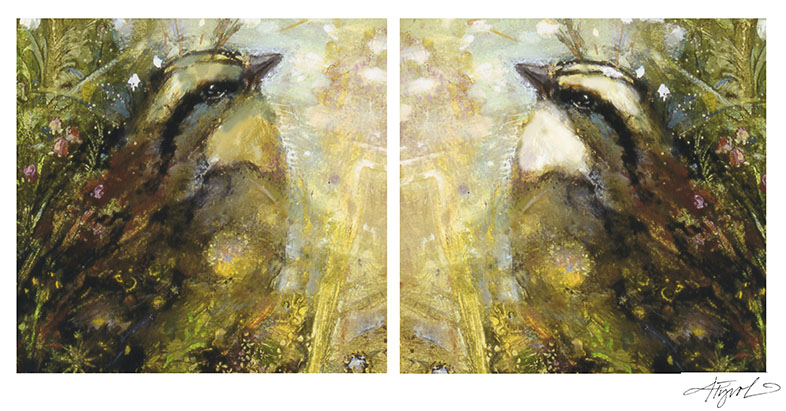
By Jackie Bussjaeger
In the wild, finding a suitable mate is no simple matter — and it’s an extra complicated affair for one familiar resident of the woods and underbrush.
With its chunky build, boldly striped head, and namesake white throat, the white-throated sparrow (Zonotrichia albicollis) is among the most common and recognizable birds of the northern forest. During the spring breeding season, one doesn’t need to go far to hear its “Old Sam Peabody-Peabody-Peabody” call, or to spot a group of these birds noisily raking for seeds in the leaf litter.
Close observers will notice these sparrows come in two distinct color varieties. Approximately half of white-throated sparrows have black and white stripes on their heads, while the other half show a duller tan-and-brown coloration. It’s not unusual for a bird species to have more than one color morph. The Eastern screech owl, for example, comes in shades of either red or gray. But for white-throated sparrows, there’s a more complex story to this variation.
In almost every case, a white-throated sparrow of either color variation will end up with a mate that has the opposite coloring: white-striped males pair with tan-striped females, and vice versa. Canadian ornithologist James Lowther, studying populations across Canada in the early 1960s, was the first to publish findings that white-throated sparrows will almost exclusively choose a mate of the opposite morph.
Lowther and researcher J. Bruce Falls of the University of Toronto together noticed something even more fascinating: color type seemed to be an exceptionally accurate predictor of an individual bird’s behavior. They noticed that white-striped sparrows of both sexes almost always seemed to show more aggressive behaviors than their tan counterparts. Both white-striped males and females sing more than tan-striped birds, and males defend their territories more rigorously and invade the territories of their neighbors more often. White-striped males are also more likely than tan-striped males to mate with other females in addition to their nesting partners, a behavior scientists refer to as extra-pair copulation.
Tan-striped birds of both sexes, in comparison, tend to be more nurturing, spending much of their time finding food and looking attentively after their partner and nestlings. However, the time they spend away from the nest sometimes leaves their mate and territory vulnerable to incursions from threats, including rival white-striped males.
This mixed bag of traits creates quite the genetic love rectangle. A 1993 study by Falls and Jeffrey G. Kopachena found that females of both colors find attentive, tan-striped males most desirable. But the white-striped females, more confrontational than their tan counterparts, snap up tan-striped males almost immediately, leaving the tan-striped females to pair off with the remaining white-striped males.
In the era of DNA analysis, scientists such as the late behavioral geneticist Elaina Tuttle have found that these characteristics are determined by a chromosomal “supergene,” tied not only to coloration but also to a wide range of behavioral traits. This unique genetic quirk means that the white-throated sparrow, as a species, effectively has four separate sexes. Individual birds need to select a mate from an eligible quarter of the population, rather than the half of the “other sex” available in other bird species.
But what happens when two same-color birds pair up? These types of pairings have rarely been observed, but as naturalist Kenn Kaufman theorized in a 2017 Autdubon article on this topic, they probably make for unsuccessful parents. Tan-striped couples might fail at defending their territory and protecting their young, Kaufman wrote, while white-striped couples might fail to bring home enough food to keep their hatchlings alive and healthy.
By settling in with a partner of the opposite coloring, white-throated sparrows can have the best of both worlds: one parent who will fiercely defend and another who will tirelessly provide. So far, this unusual strategy has worked well. For white-throated sparrow offspring, the stripe colors will be split nearly 50/50 in a single brood, preserving the balance of the two color forms and their associated personality traits within the greater population.
As the days grow longer and new leaves unfurl, the white-throated sparrow’s melodious song will once again sound through the forest. As you enjoy their charismatic singing and familiar appearance, take a closer look—is this a white-striped male staking out a territory? A tan-striped female foraging dutifully to support her nestlings? Whichever bird you see, there are endless questions to ask about the lives of the wildlife that make their homes in our own favorite patch of forest.
Jackie Bussjaeger is a writer and naturalist in Minnesota and Western Wisconsin. The Outside Story is assigned and edited by Northern Woodlands magazine and sponsored by the Wellborn Ecology Fund of the NH Charitable Foundation: nhcf.org.




